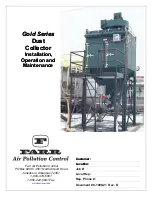
-22-
Model W1687 (For Machines Mfg. Since 9/11)
O
PE
R
ATIO
NS
Dust
Collector
Figure.26
. Basic sketch of shop layout.
System.Design
Decide.Who.Will.Design
For most small-to-medium sized shops, you can design and
build the dust collection system yourself without hiring
engineers or consultants. We have included some basic
information here to get you started on a basic design.
If you have a large shop or end up designing a
complicated system, then we recommend additional
research beyond this manual, or that you seek the help of
an expert.
Sketch.Your.Shop.Layout
When designing a successful dust collection system,
planning is the most important step. In this step, you
must sketch a basic layout of your shop, including space
requirements of different machines. Your sketch only
needs the basic details of the shop layout, similar to
the following figure, including all your current/planned
machines and your planned placement of the dust
collector.
Main
Line Duct
Branch
Line
Ducts
GOOD
Dust
Collector
Figure.27
. Efficient duct layout.
BAD
Dust
Collector
Figure.28
. Inefficient duct layout.
Sketch.a.Basic.Duct.Layout
For the next step, sketch how you will connect your
machines to the dust collector. Consider these general
guidelines for an efficient system:
1.
Machines that produce the most saw dust should be
placed nearest to the dust collector (i.e. planers and
sanders).
2.
Ideally, you should design the duct system to have
the shortest possible main line and secondary branch
ducts. See the following figures for ideas of efficient
versus inefficient duct layouts.
3.
Directional changes should be kept to a minimum.
The more directional change fittings you use directly
increases the overall resistance to airflow.
4.
Gradual directional changes are more efficient than
sudden directional changes (i.e. use the largest
corner radius possible when changing hose or pipe
direction).
5.
Each individual branch line should have a blast gate
immediately after the branch to control suction from
one machine to another.
6.
The simpler the system, the more efficient and less
costly it will be.
































